15 Native Plants for Illinois Landscapes
BY LYDIAN PINE | JUNE 6TH, 2023 | ILLINOIS, LAWN CAREIllinois has a diverse climate full of fluctuating temperatures, cold winters, and hot summers. The climate supports a variety of plants, including vibrant perennials and hardy evergreens. Illinoisians encounter native plants decorating farmlands, parks, yards, and more. Discover 15 native plants for Illinois landscapes and add some local, Land-of-Lincoln color to your yard.
In this article, we will cover:
- 15 Native Plants for Your Illinois Yard
- How to Choose Native Plants for Your Illinois Yard
- FAQ About Native Illinois Plants
- Where to Find Native Plants in Illinois
15 Native Plants for Your Illinois Yard
Native plants offer many landscaping benefits, including:
- Native plants support Illinois’ diverse ecosystem, providing food and shelter for local wildlife, birds, and insects.
- They are acclimated to the fluctuating continental climate and four seasons.
- They are low-maintenance, surviving Illinois winters, local insects, and disease.
1. Blue Flag Iris (Iris virginica var. shrevei)
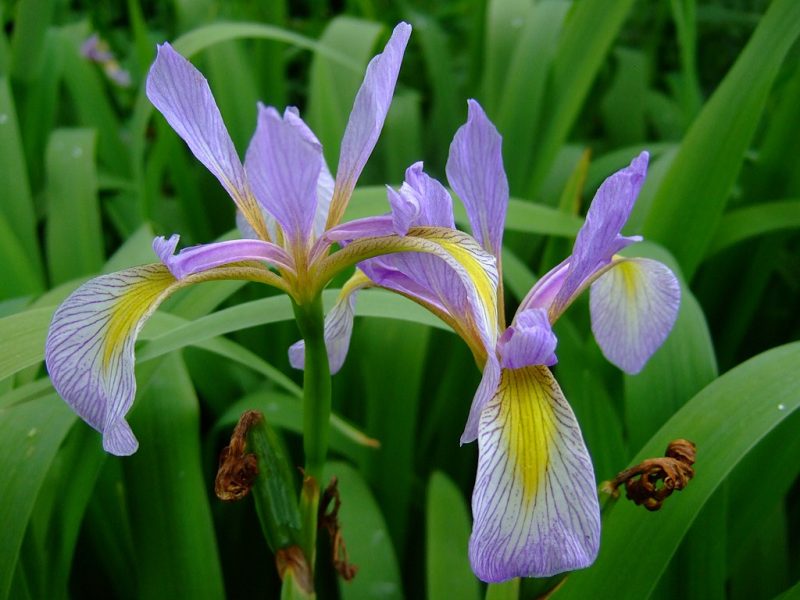
Photo Credit: James Steakley / Wikimedia Commons / CC BY-SA 4.0
Blue flag iris thrives in wet environments throughout Illinois, making it a great addition to ponds, streams, or rain gardens. Its tall stems bloom large violet-blue flowers, and its dense clumps of bright green leaves rest on water or ground. They provide nectar for hummingbirds and groundcover for amphibians, snakes, and insects.
Blue flag iris prefers wet, acidic soil and tolerates flooding up to three inches. Specimens grow up to three feet tall and bloom from May to June. The perennial is resistant to most pests and diseases, including deer.
Growth habit: Herbaceous flower
USDA hardiness zone: 5-9
Mature size: 2-3 feet tall and wide
Duration: Perennial
Foliage: Deciduous
Sunlight needs: Full sun; partial shade
Soil preferences: Moist, poorly-drained clay or loam
Water needs: Flood-tolerant; water frequently to keep soil moist
Potential hazards: Toxic; poisonous roots
Blue vervain is a popular choice for Illinois gardens. The perennial has spikes of small purple flowers that attract pollinators. Its dried winter seeds and shoots are a source of food for native wildlife. This tall, clump-forming wildflower has candelabra-shaped stems that grow up to five feet tall once established.
2. Blue Vervain (Verbena hastata)
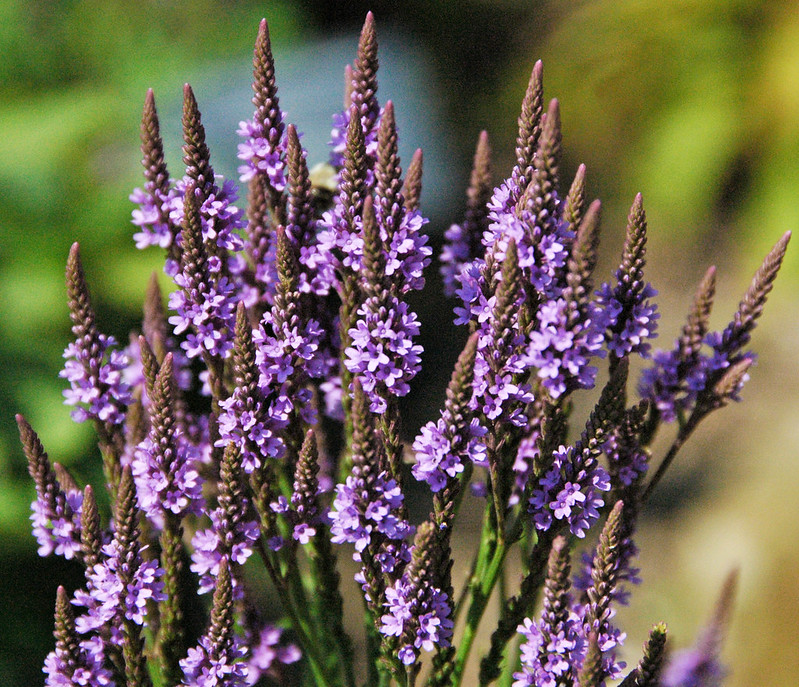
Photo Credit: James St. John / Flickr / CC BY 2.0
Blue vervain prefers full sun but adapts to shady conditions. It blooms from July to September. Specimens are drought-tolerant and make a low-maintenance addition to borders, rain gardens, ponds, and containers.
Growth habit: Herbaceous flower
USDA hardiness zone: 3-9
Mature size: 2-5 feet tall and 1-3 feet wide
Duration: Perennial
Foliage: Deciduous
Sunlight needs: Full sun; partial shade; shade
Soil preferences: Moist, well-drained chalk, loam, or sand.
Water needs: Water one inch per week
Potential hazards: Non-toxic; no safety hazards
3. Common Blue Violet (Viola sororia)
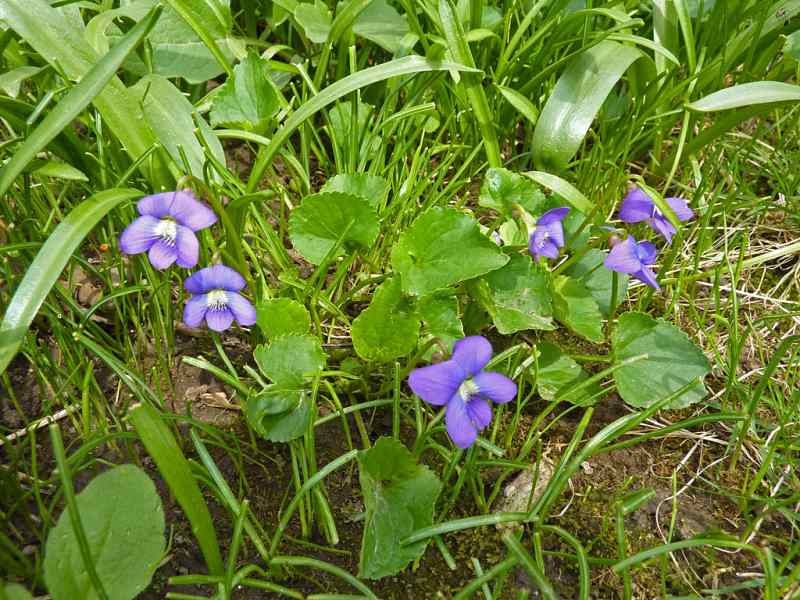
Photo Credit: James Steakley / Wikimedia Commons / CC BY-SA 3.0
Common blue violet is recognized as Illinois’ state flower. Also known as the purple violet or wooly blue violet, this perennial thrives in areas with filtered sunlight like forest floors. Specimens are easily recognizable courtesy of their broad, heart-shaped leaves and purple blooms with white central petals.
Common blue violet is deer-resistant and an excellent pollinator. It is edible, and the leaves and flowers are rich in vitamins.
Growth habit: Herbaceous flower
USDA hardiness zone: 3-10
Mature size: 6-10 inches tall and wide
Duration: Perennial
Foliage: Deciduous
Sunlight needs: Full sun; partial shade
Soil preferences: Adaptable; moist, well-drained chalk, loam, or clay
Water needs: Drought-tolerant; water one in per week; allow to dry out between watering
Potential hazards: Non-toxic; edible
4. Common Milkweed (Asclepias syriaca)
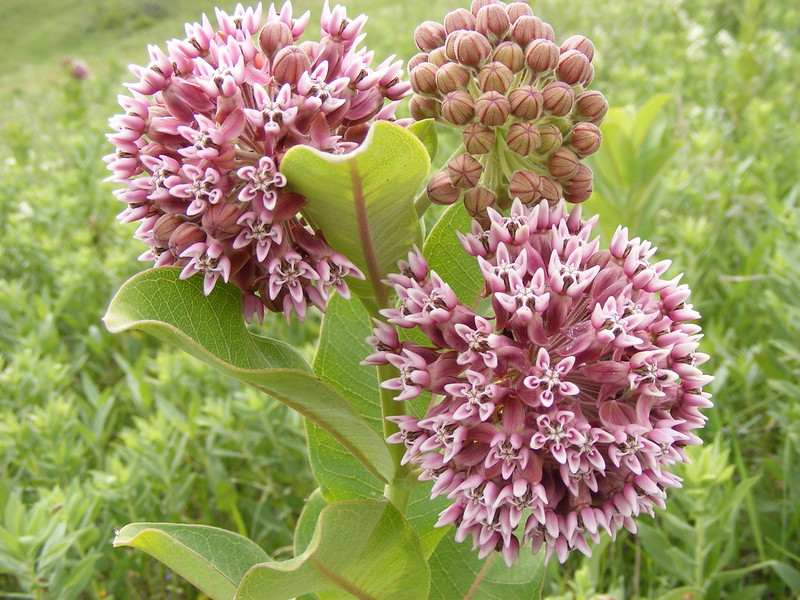
Photo Credit: USFWS Mountain-Prairie / Flickr / CC BY 2.0
Milkweed is so widespread across Illinois that it was adopted as the state wildflower in 2017. It is an herbaceous perennial with domed clusters of pale pink and white flowers. It thrives in full sun and is drought-tolerant. Common milkweed blooms in the summer and is an essential host plant for the endangered Monarch butterfly, the state butterfly of Illinois.
Common milkweed is low-maintenance, deer-resistant, and generally disease and pest-free. It is a great choice for butterfly or container gardens and flower beds.
Growth habit: Herbaceous Flower
USDA hardiness zone: 3-9
Mature size: 3-4 feet tall and 12 inches wide
Duration: Perennial
Foliage: Deciduous
Sunlight needs: Full sun
Soil preferences: Adaptable; well-drained chalk, sand, loam, or clay
Water needs: Water one inch per week during dry periods
Potential hazards: Toxic; mildly poisonous to humans and animals; irritating sap
5. Cup Plant (Silphium perfoliatum)
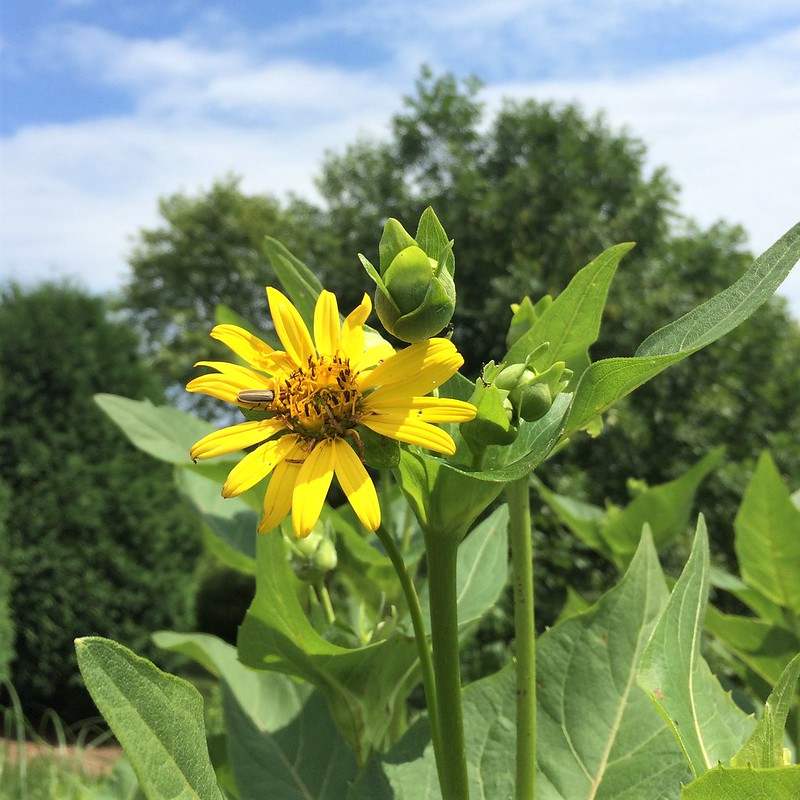
Photo Credit: Aaron Volkening / Flickr / CC BY 2.0
Cup plant survives the extreme Midwestern winters thanks to dormant, cold-weather roots. The herbaceous flowering plant grows up to eight feet tall with toothed leaves and daisy-like blooms.
Thanks to the shape of its flowers, water accumulates inside like a cup. Cup plant is an excellent backyard specimen that is deer-resistant and has no serious disease or pest issues.
Growth habit: Herbaceous flower
USDA hardiness zone: 3-9
Mature size: 4-8 feet and 1-3 feet wide
Duration: Perennial
Foliage: Deciduous
Sunlight needs: Full sun
Soil preferences: Moist, well-drained loam
Water needs: Drought-tolerant; water one inch per week
Potential hazards: Non-toxic; no safety hazards
6. Golden Alexanders (Zizia aurea)
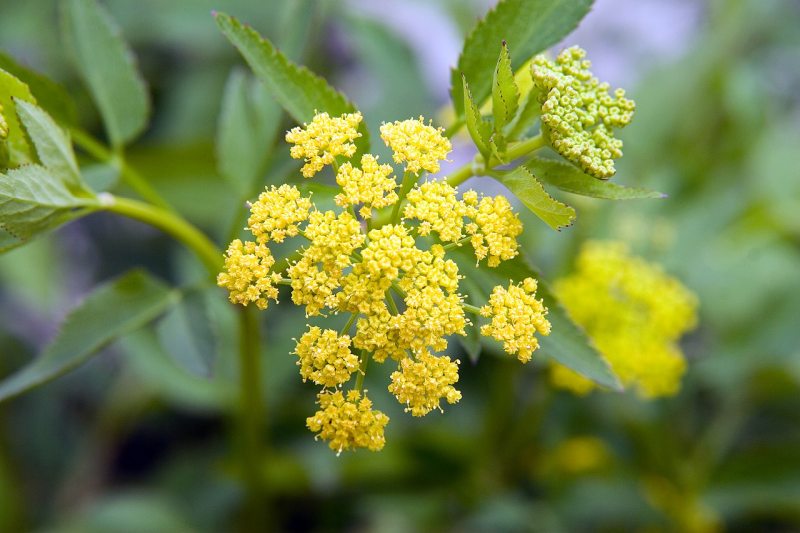
Photo Credit: Photo by David J. Stang / Wikimedia Commons / CC BY-SA 4.0
Golden Alexanders is a low-maintenance, low-growing plant that is highly adaptable. It thrives in lawns with moist soils and partial to full sun but tolerates a range of soils and conditions, including drought. Golden Alexanders blooms large clusters of tiny yellow flowers during mid to late spring. These flowers are a great source of nectar for beneficial insects.
Growth habit: Herbaceous flower
USDA hardiness zone: 3-8
Mature size: 1-3 feet tall and wide
Duration: Perennial
Foliage: Deciduous
Sunlight needs: Full sun; partial shade
Soil preferences: Adaptable; moist, well-drained clay, loam, or sand
Water needs: Adaptable; water one inch per week during the growing season
Potential hazards: Toxic; poisonous in large quantities
7. Indian Paintbrush (Castilleja coccinea)
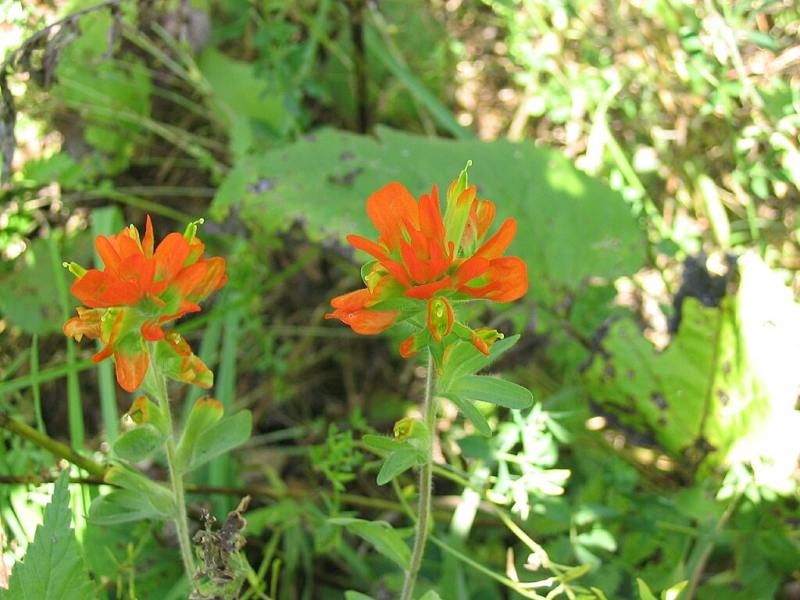
Photo Credit: Superior National Forest / Wikimedia Commons / CC BY 2.0
Indian paintbrush blooms red to orange flowers that resemble spikes that have been dipped in paint. The herbaceous perennial is a hemiparasite, meaning it parasitically relies on other plants for some of its nutrients. Indian paintbrush blooms from late spring to early summer and grows in sandy areas. It attracts many pollinators and controls competition in the garden, creating a balanced ecosystem.
Growth habit: Herbaceous flower
USDA hardiness zone: 4-8
Mature size: 1-2 feet tall and wide
Duration: Perennial
Foliage: Deciduous
Sunlight needs: Full sun
Soil preferences: Moist sand
Water needs: Water one inch per week; allow the soil to dry out between waterings
Potential hazards: Toxic; poisonous to humans and animals
8. Lady’s Leek (Allium cernuum)
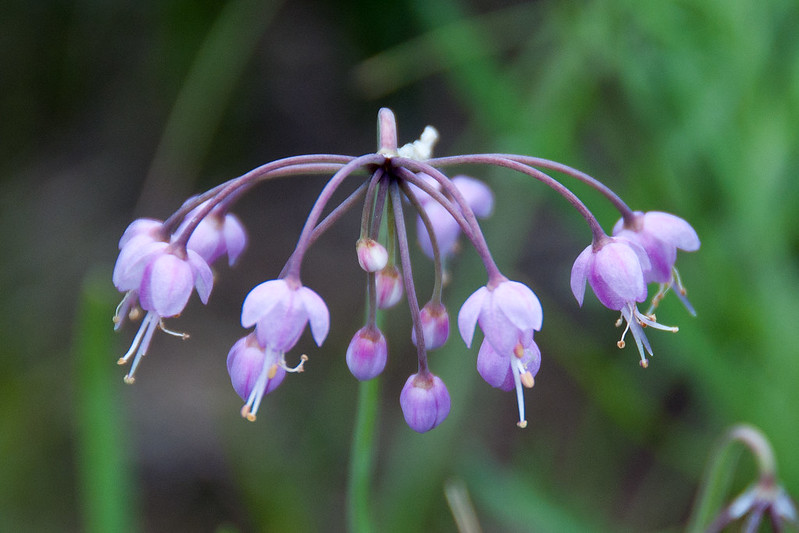
Photo Credit: Paul Asman and Jill Lenoble / Flickr / CC BY 2.0
Lady’s leek, or nodding wild onion, belongs to the genus Allium, similar to onions and garlic. It has long, leafless stalks with clusters of capsule-like fruits and a distinct pink or purple bloom. It grows in open areas of North America.
Lady’s leek has a strong scent. Specimens can be cooked or used raw to season food. It is an ideal plant for your home gardens and is long-lived and hardy.
Growth habit: Bulb
USDA hardiness zone: 3-9
Mature size: 1-2 feet tall
Duration: Perennial
Foliage: Deciduous
Sunlight needs: Full sun; partial shade
Soil preferences: Adaptable, moist, well-drained chalk, clay, loam, or sand
Water needs: Water one inch per week
Potential hazards: Non-toxic; edible; little culinary value today
9. New England Aster (Aster novae-angliae)
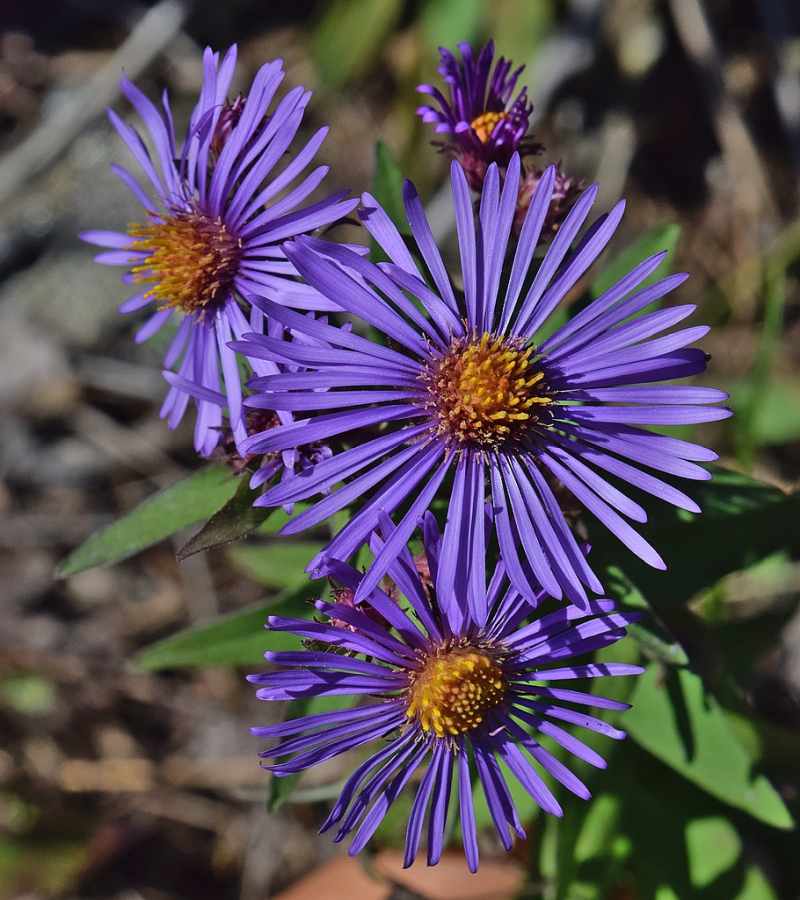
Photo Credit: The Cosmonaut / Wikimedia Commons / CC BY-SA 2.5 CA
New England aster forms multi-stemmed clusters of lavender, pink, or purple flowers with a yellow center. This drought-tolerant and deer-resistant native thrives in all but the driest soils. New England aster prefers partial to full sun, and mature plants grow up to six feet tall. Specimens provide waterfowl coverage and attract pollinators and beneficial insects.
Growth habit: Herbaceous flower
USDA hardiness zone: 4-8
Mature size: 3 – 6 feet
Duration: Perennial
Foliage: Deciduous
Sunlight needs: Full sun; partial shade
Soil preferences: Moist, well-drained clay, loam, sand, or chalk
Water needs: Water once to twice weekly to maintain moist soil
Potential hazards: Non-toxic; edible
10. Oakleaf Hydrangea (Hydrangea quercifolia)
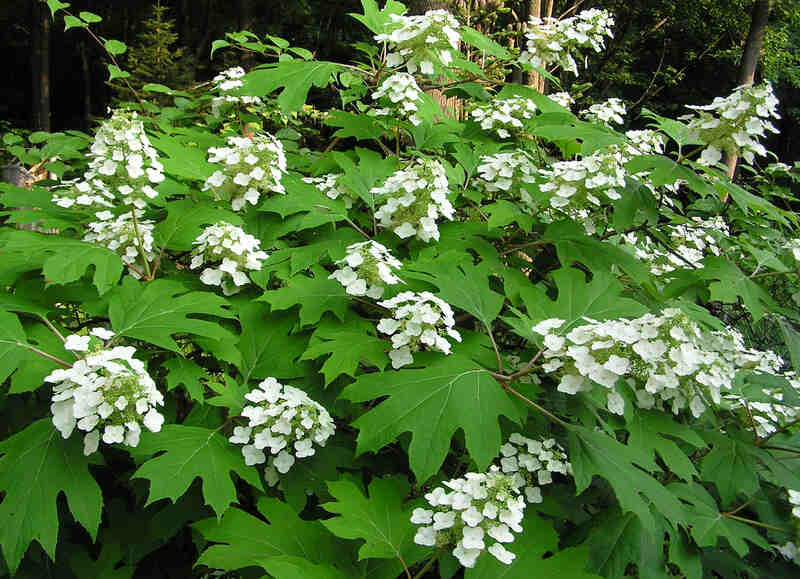
Photo Credit: normanack / Flickr / CC BY 2.0
Named for its broad, dark green leaves that resemble oak leaves, oakleaf hydrangea is a great shrub for small spaces or borders as an informal hedge. It grows between four to six feet tall and blooms clusters of tiny, white flowers.
Oakleaf hydrangea blooms in early spring until midsummer. Cultivars have no serious insect or disease problems and thrive in moist soils. Be sure to prune the flowering shrub as soon as it is done flowering to promote new growth.
Growth habit: Shrub
USDA hardiness zone: 5-9
Mature size: 6-10 feet high and 6-8 feet wide
Duration: Perennial
Foliage: Deciduous
Sunlight needs: Full shade to partial shade
Soil preferences: Adaptable; prefers, fertile, well-drained soil
Water needs: Moderately drought-tolerant; prefers moist soil
Potential hazards: Toxic; all plant parts are poisonous to humans and animals
11. Ohio Spiderwort (Tradescantia ohiensis)
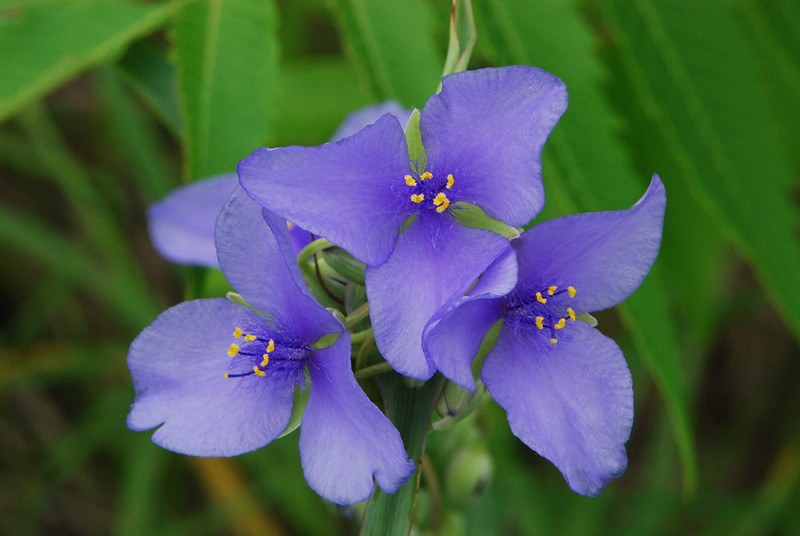
Photo Credit: Joshua Mayer / Flickr / CC BY-SA 2.0
Ohio spiderwort is a quick-spreading, low-maintenance garden plant that also makes a great houseplant. Specimens often resemble long grass or lilies. The flowers are blue or purple with pale central petals. Ohio spiderwort is drought-tolerant and prefers dry soil. The perennial blooms from May to mid-October and grows two to three feet tall.
Growth habit: Herbaceous flower
USDA hardiness zone: 4-9
Mature size: 2-3 feet tall and 1-3 feet wide
Duration: Perennial
Foliage: Deciduous
Sunlight needs: Full sun; partial shade
Soil preferences: Well-drained clay, loam, or sand
Water needs: Water every 2-3 days during dry spells; prefers moist soil
Potential hazards: Non-toxic; no safety hazards
12. Purple Coneflower (Echinacea purpurea)
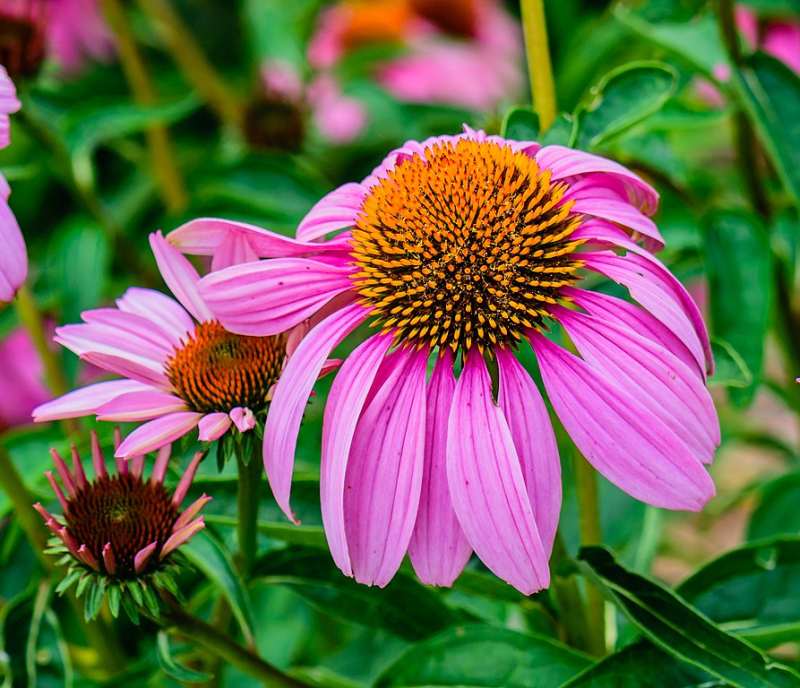
Photo Credit: PumpkinSky / Wikimedia Commons / CC BY-SA 4.0
Purple coneflower is a perennial herb with purple petals surrounding a burnt orange head atop tall stems. Specimens grow throughout Illinois meadows and open woods. Purple coneflower is low-maintenance and suitable for beginning gardeners. The plant attracts several pollinators and birds, making it a great addition to a wildlife or butterfly garden.
Growth habit: Herbaceous flower
USDA hardiness zone: 3-8
Mature size: 2-5 feet tall and 1-2 feet wide
Duration: Perennial
Foliage: Deciduous
Sunlight needs: Full sun; partial shade
Soil preferences: Dry, well-drained sand
Water needs: Water one inch per week
Potential hazards: Non-toxic; no safety hazards
13. Purple Prairie Clover (Dalea purpurea)
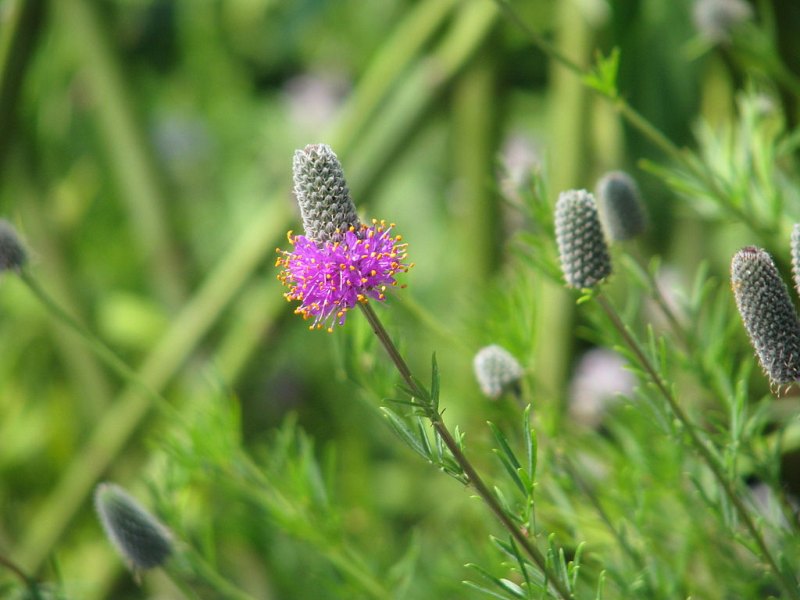
Photo Credit: peganum from Henfield, England / Wikimedia Commons / CC BY-SA 2.0
Purple prairie clover grows across Northern and Central Illinois and is recognized by its conical, thimble-shaped purple flowers. It blooms in summer and attracts butterflies, wasps, bees, and birds. It is a food source for various herbivores, such as the pronghorn, and is hay for livestock.
Purple prairie clover thrives in sunny locations with average to dry soils. It has large taproots, which can extend down to six feet below the soil. Specimens are crucial for revegetation, and its long taproot system prevents soil erosion.
Growth habit: Herbaceous flower
USDA hardiness zone: 3-8
Mature size: 1-3 feet tall and 1-2 feet wide
Duration: Perennial
Foliage: Deciduous
Sunlight needs: Full sun
Soil preferences: Moist, well-drained clay, loam, sand, or chalk
Water needs: Drought-tolerant; water one inch per week
Potential hazards: Non-toxic; edible leaves
14. Sweet Gum (Liquidambar styraciflua)
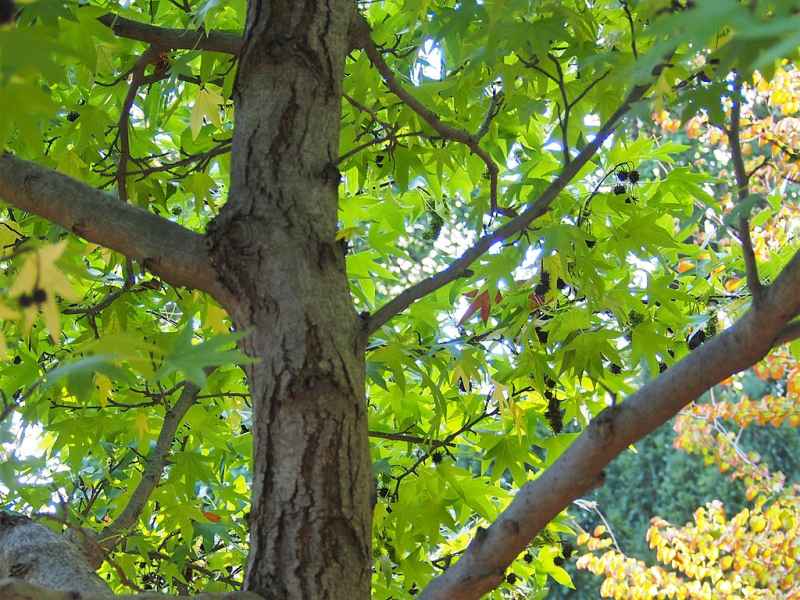
Photo Credit: Agnieszka Kwiecień, Nova / Wikimedia Commons / CC BY-SA 4.0
Sweet gum is a native shade tree with a narrow trunk and star-shaped leaves that change to shades of orange, yellow, red, and purple in the Fall. It thrives in full sun. After its flowering season, sweet gum produces spiky balls that drop to the ground. Be sure to plant specimens away from foot traffic.
Growth habit: Tree
USDA hardiness zone: 5-9
Mature size: 30-50 feet tall and 25-40 feet wide
Duration: Perennial
Foliage: Deciduous
Sunlight needs: Full sun
Soil preferences: Moist, well-drained clay, loam, or sand
Water needs: No watering needs outside of natural rainfall
Potential hazards: Non-toxic; no safety hazards
15. Wild Bergamot (Monarda fistulosa)
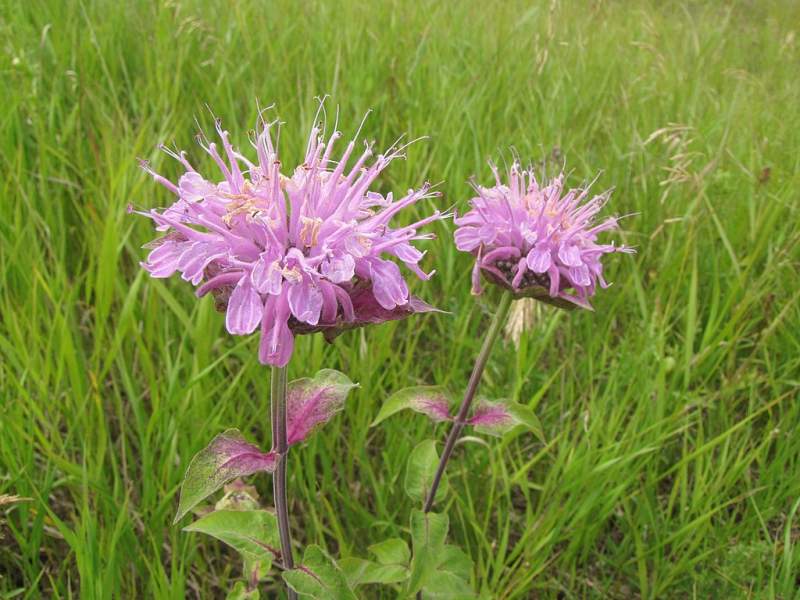
Photo Credit: USFWS Mountain-Prairie / Wikimedia Commons / Public domain
Wild bergamot, also known as bee balm, grows throughout Illinois, except in the southernmost regions. Its nectar attracts native pollinators and hummingbirds. The herbaceous flower grows up to five feet tall with three-inch, toothed leaves. Establish specimens from seed or cuttings.
Wild bergamot prefers full sun to partial shade and can withstand drought thanks to its deep roots. Its roots make it a great choice for stabilizing slopes and erosion control. The perennial blooms pink or lavender flowers in summer that last until October. Wild bergamot is a member of the mint family and has a scent similar to oregano and mint.
Growth habit: Herbaceous flower
USDA hardiness zone: 3-8
Mature size: Up to 5 feet tall
Duration: Perennial
Foliage: Deciduous
Sunlight needs: Full sun; partial shade
Soil preferences: Adaptable; intolerant of flooding
Water needs: Water once per week in the spring and fall and twice per week in the summer
Potential hazards: Non-toxic; edible with medicinal uses
How to Choose Native Plants for Your Illinois Yard
When selecting plants for your yard, keep your hardiness zone in mind. Illinois is located in USDA Hardiness Zones 4b to 6b, which means that Illinois experiences four distinct seasons. All Illinois native plants are hardy to the lowest annual temperatures, approximately -20 degrees Fahrenheit.
FAQ About Native Illinois Plants
Native plants can look wild and untamed. They often attract unwelcome wildlife like field mice.
There are almost 2,300 native plant species in Illinois.
Only four prairie buttercup specimens have been spotted since 2007. The native wildflower grows in dry gravel and dolomite prairies in north-central Illinois.
Where to Find Native Plants in Illinois
Various organizations in Illinois preserve the original flora and educate people about the significance of native plants. Here are a few things you can do if you want to locate native plants for your landscape:
- Visit a local native plant nursery or botanical garden
- Learn more about native plants from Illinois’s Native Plant Society
- Check out the University of Illinois’ list of plants native to the state
If you don’t have enough time, energy, or experience to care for your garden, let Wikilawn connect you with an Illinois lawn care pro. From Alton, Carol Stream, to Oak Park, Downers Grove, and more, the experts can mow, edge, weed, and help you pick the best native plants for your landscape.
Main Photo Credit: Grant Park, Chicago / Alanscottwalker / Wikimedia Commons / CC BY-SA 3.0